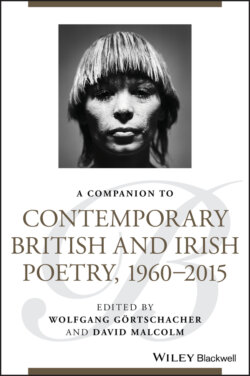Читать книгу A Companion to Contemporary British and Irish Poetry, 1960 - 2015 - Группа авторов - Страница 34
D. S. Marriott, “The Wreck of the Mendi” (2008) (Marriott 2008, 98–101)
ОглавлениеThe poem uses the traditional genre of the elegy to mourn the 616 Black South African soldiers drowned when their ship sank in the English Channel in 1917. The poem's epigraph is a dedication to these soldiers, and it and the text proper refer to the documented circumstances of the sinking and the deaths. The subject matter is presented in three sections: sections I and II offer complementary narrative accounts of the sinking and the conduct of the soldiers as they meet death; section III views the event from the speaker's present, looks at the result of the disaster, and ends in a (traditional) memorial for those lost at sea. Each section begins with a long sentence, stretching over several three‐line stanzas, followed by shorter ones.
The speaker of the poem is unnamed, and, indeed (unlike the speaker in Hopkins's “The Wreck of the Deutschland”—to which the poem's title and subject matter clearly refer), makes no appearance within the poem. Unlike Hopkins's text, too, the poem is written in what is effectively free verse. The three‐line stanzas have lines of quite substantially varying lengths. Main stresses, too, vary, although only from two to four. The piece is unrhymed. Relatively short lines allow a focus on the constituent phrases of the text, for example, in the second stanza of section II: “the hull breached, overrun / men in the wrack / gasping in a peopled darkness.” This appears to be the only function of such division.
However, the poem is marked by a far from prosaic linguistic strategy. There is a degree of lexical and consequently semantic mystery to the text. For example, “instress” is used twice (in I.5 and II.8), but not in any sense that Hopkins would recognize. Equally unusual is the use of the word “burls” (a burl is a growth on a tree with a deformed grain) in II.1. (“Burl” occurs in a similar metaphorical sense in “The Wreck of the Deutschland.”) The word “reeved” (twined, twisted) is used in II.7—and it is used in “The Wreck of the Deutschland” too. The word “tain” (a French word—not strictly an English one—for the silvering used on mirrors) occurs in II.5, along with “dredges” as a plural noun (this last is very obscure, unless the meaning of a mixture of grains, like the mixture of the South African dead, is being activated).
Further, there is a marked degree of opacity of reference in many phrases. It is very hard to gloss I.9. The relevance of the phrase “less the lash” in II.1 is not clear. (Is it a reference to slavery or indentured labor, but, if so, why is it here? Is it a reference to Hopkins's verse?) It is difficult to paraphrase II.7 and II.8. While the general import of III.1 can be intuited—the “black load‐bearers” are the dead—but who is the “him” that they carry? One certainly must work to unpick the complexities of III.5—the “unaccounted‐for blood,” prayers silvering the “dredges.” However, this is not incompetence, but an essay at a vatic dignity—and one that recalls Hopkins's verbal strategy in “The Wreck of the Deutschland.” The substantially forgotten, marginalized Black soldiers (abandoned to their fate by the vessel that sank the Mendi) are recalled into a dignified mystery. Introductory sentences are suitably grand, references are to a canonical English poem, and the dead are reshaped in numinous mystery. They are themselves, South Africans of many peoples, who meet a cruel end nobly, but the poem's ending locates them as some of the British maritime war dead who “have no grave but the sea” (quoting from the Tower Hill Memorial). They are at once marginal to and yet assimilated to and instated in a national memory.
